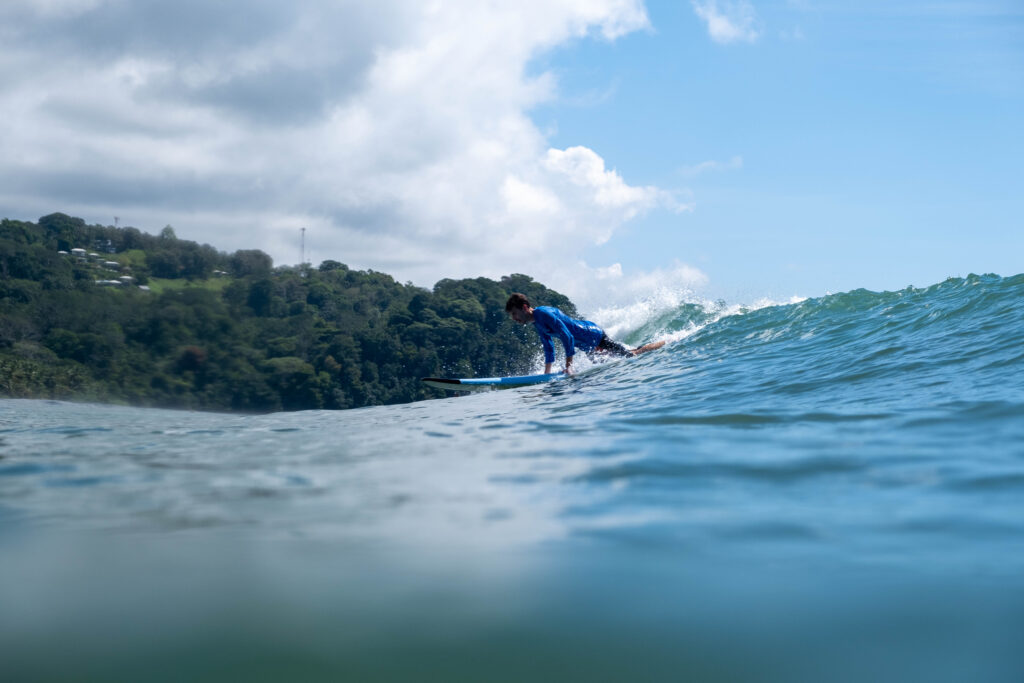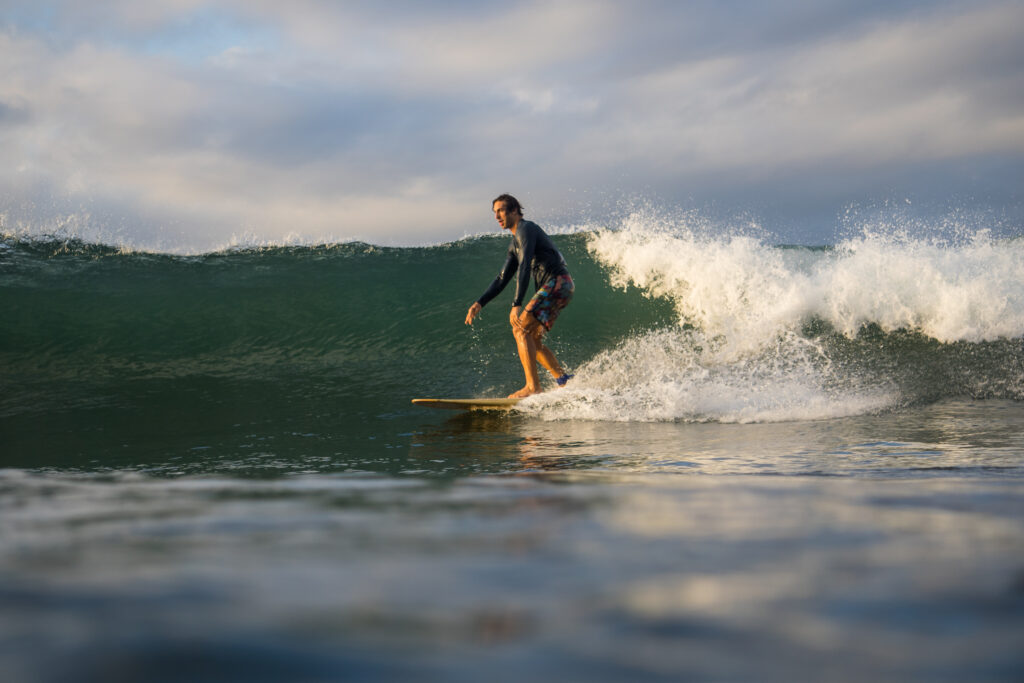I’ve been getting a lot of questions about surfing injuries lately such as: “What are the most common injuries for surfers?” and “How can surfing injuries be avoided?”. While the risk of injury does exist in surfing (as it does in any other sport), surfing is a low-impact sport and an activity that one can practice well beyond their physical prime with a low risk of serious physical injury. This also makes it a great sport to take up later in life.
These questions have made me reflect about the most common and unforeseen minor injuries, also known as “boo-boos”, that guests have endured during our Bodhi Sessions surf and yoga camp. If you are considering attending a surf camp, you may want to read the list below, (presented in order of most to least common), and pay close attention to the tips provided on how to prepare for and/or avoid these common surfing boo-boos altogether. This list isn’t designed to deter you from spending a week learning to surf, but rather to help you prepare; whether that be in setting your expectations, or providing you with some information of items to pack before leaving home which will help you prevent these boo-boos in the first place.
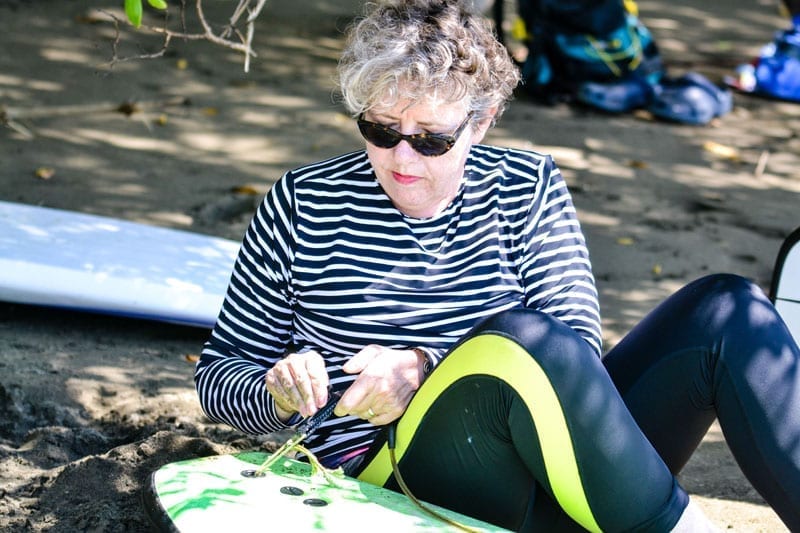
Surf rashes
Surfing rashes are caused by skin rubbing against itself or some material such as surf wax, the top layer of soft top surfboards, board shorts, or wetsuits, and usually after multiple days in a row. The most common areas where rashes occur are the chest or nipples (for men specifically), the stomach, the knees, the inner thighs, and the armpit and neck area.
Surf rashes top the list because there is not much that you can do to prevent them from happening, they are simply part of surfing. A change in attire is also likely to leave a rash: if a surfer is accustomed to wearing a wetsuit and takes a surf trip to some tropical destination, that wetsuit which protects their sensitive skin won’t be necessary and hence they’ll be likely to develop a chest/nipple, stomach or knee rash; or conversely, a surfer that goes from warm water to cold water will be required to leave his board shorts behind and adapt to using a wetsuit.
Luckily our bodies adapt rather quickly, and the areas of skin that rub up against the foreign material toughen up, allowing us to enjoy the water without that annoying stinging sensation. Here are some tips to help reduce the occurrence of this minor surfing injury:
- Wear a rash guard when surfing in tropical water to avoid chest, nipple, and stomach rashes
- Pay close attention to avoid dragging yourself up and down the surfboard, which is one of the primary reasons that beginners experience knee rashes
- Ladies with sensitive skin may want to consider rash guard pants to help prevent knee rashes
- If you’re learning to surf in cold water, get yourself a mid to high end wetsuit as the materials used for these wetsuits will be softer and thus less likely to create friction against your skin
- Avoid walking great distances in wet board shorts; if you have to walk to the surf break, take a towel and a dry pair of shorts to change at the beach once you’re done
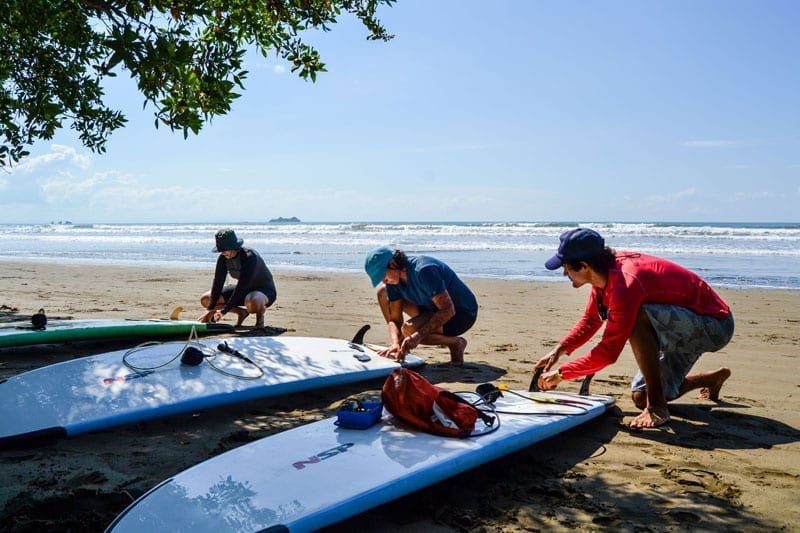
Sunburns
Sunburns are not exclusive to surfers or those learning to surf; but when you’re surfing, you will be focusing on the waves, having fun, and feeling refreshed in the ocean, so you are likely to forget that you’re exposed to the sun for the entire surf session. This is particularly important to keep in mind if you are surfing in a warm, tropical climate such as Costa Rica! I can’t stress the importance of taking the necessary precautions to avoid, or at the very least reduce the risk of, sunburns.
At Bodhi Surf School we do our best to avoid mid-day surf sessions to help reduce the amount of sun exposure, and in general we recommend our guests be cautious about being out in the sun between 11am and 2pm. Below are the sunburn prevention tips we give our guests:
- Wear a rash guard, preferably one that is long sleeved
- If your skin burns easily, look into rash guard pants in addition to the long sleeved rash guard
- Apply non-toxic sunblock to exposed areas, particularly the face but it may also be necessary on the hands, neck, calves, and feet (depending on how sensitive your skin is to the sun)
- Hats that can be fastened around the chin (surf hats) are highly recommended for individuals who burn very easily and those without hair to protect their heads
- Aim to surf in the early morning or late afternoon
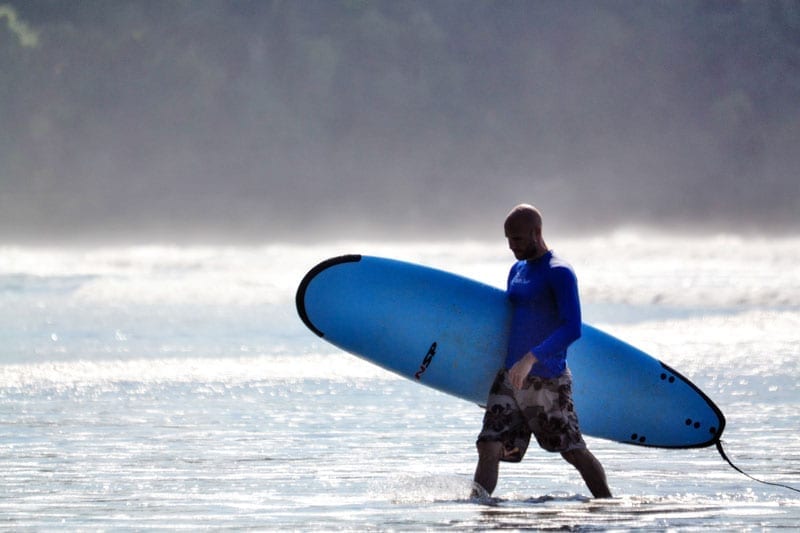
Bruises
The highest risk of serious injury when learning to surf comes from your own equipment — the surfboard. At Bodhi Surf School, we emphasize surfboard management and spend a significant amount of time teaching our students how to properly control their surfboards both in and out of the water. But regardless of how much safety and surfboard control theory is covered at any surf camp, there will still be a certain probability that you may still hit yourself with your board.
To help reduce the risk of serious injury at Bodhi Surf School, we utilize NSP soft top boards which have a hard inner core and a soft outer layer wrapping. While they are not the softest surfboards available on the market, they provide a good middle ground between safety and performance. Here are a few tips for reducing the chance of getting hit by your surfboard:
- Never have the surfboard between your body and an oncoming wave
- Always be aware of your equipment
- Keep control of your surfboard with both hands
- If you’re a beginner and renting a surfboard, look for a soft or soft top surfboard
- Attend a surf camp and learn the basics before going off and surfing on your own
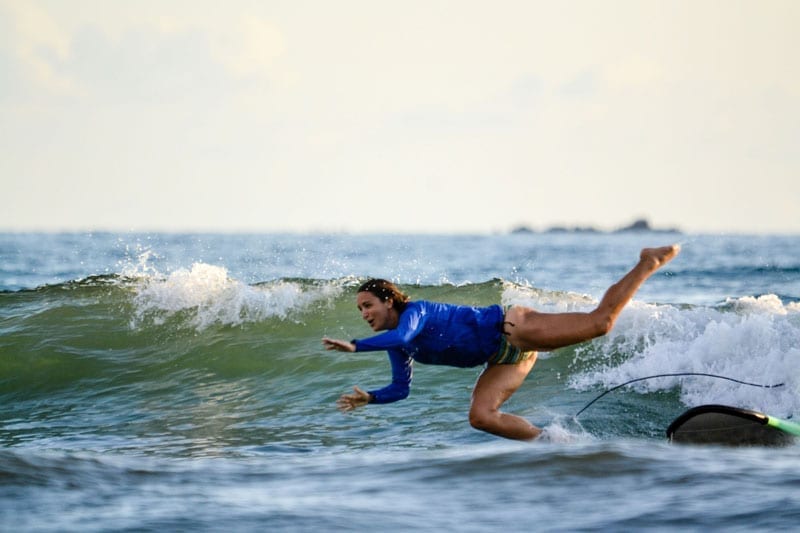
Water in the ear
Getting water in the ear is bound to happen, again, it’s part of the price you pay not just when learning, but in general as a surfer. Note that I’m not talking about ear infections, which can arise from having water in the ear, but rather about that uncomfortable feeling of one ear canal feeling like it’s plugged up.
Getting water in your ear may occur when you take a bad spill when surfing and either go ear-first into the water or get tumbled by a wave. Having water in the ear is not a serious issue, it’s just rather uncomfortable, and can lead to infection if not removed. The best way to avoid getting water in your ear is to wear ear plugs.
If you do experience water in your ear then you’ll want to dry it out to avoid the risk of having an ear infection develop. Some effective ways for getting water out of your ear are:
- Using gravity to drain the water: pulling your earlobe and tilting your head sideways
- Yawning or chewing to help get the water moving
- Doing the Valsalva maneuver, which consists of taking a breath, plugging your nose with your fingers, and gently exhaling out so you hear a popping sound
- Creating a vacuum by placing the palm of your hand against the affected ear, tilting your head, and then cupping your hand so that the palm of your hand moves away from the ear canal so your hand acts as a suction cup
- Allowing clean, warm water into your affected ear and then quickly tilting your head to allow it to drain out
There are also over-the-counter ear drops drops that can be purchased at many pharmacies (including our own here in Bahia Ballena) that help dry out water in the ear, which should do the trick if all else fails.
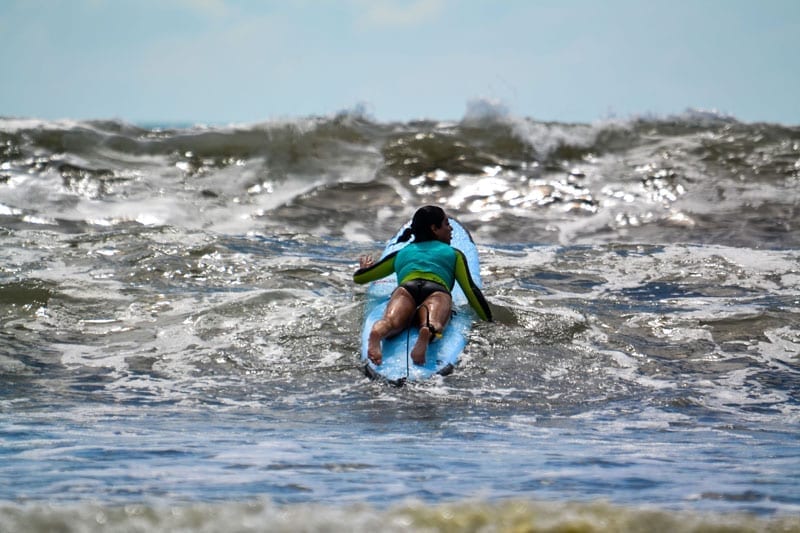
Sore ribs
In surfing you spend a lot of time lying on your stomach on the board, and when you are not used to this, your abs and ribs will feel the repercussions. Also, as you paddle up and over a wave, it’s possible that the surfboard will drop with significant force and if you’re not absorbing the impact of that drop with your hands, it will be your ribs taking on that impact.
As your comfort level on the surfboard increases, the likelihood of sore ribs will decrease. Here are a few tips to help you avoid the risk of sore ribs when learning to surf:
- Do exercises that help you strengthen your core
- Give your body a rest day or two when you are surfing a lot so that it has a chance to recover
- Learn to use your hands to absorb any impact with the surfboard
- Avoid rocking your core side to side when in the prone position on a surfboard
I hope this list help you prepare as you begin to learn to surf, or for your upcoming surf camp. If you’ve already started to learn to surf, feel free to share any boo-boos that you experienced which could help those just starting out know what to expect and how to prevent these types of minor injuries.

For First-Time Surfers
You Don't Need Experience. You Don't Need Gear. You Just Need This.
Our free 5-day email course that reveals the 5 myths keeping beginners at "I'm not ready" instead of catching their first wave and finding inner peace-and how to overcome them fast.
Change the heading on the Separator tab ->
Search
The Newbie Surf + Yoga Camp Kickstarter
Bust the 5 biggest myths about going to a surf and yoga camp so you can stop procrastinating and start catching waves - with our FREE 5-day email course.
Change the heading on the Separator tab ->
Most Read Blogs
What is the Meaning of Anjali Mudra?
May 27, 2020
Fitness for Surfers: Workouts, Exercises & Training
February 10, 2022
The Best Places to Eat in Uvita, Costa Rica
May 19, 2022
How to Get From SJO to Costa Ballena, Costa Rica
May 31, 2018
Change the heading on the Separator tab ->
Categories
Categories
- Bodysurfing (5)
- Food (8)
- Responsible Business (6)
- Surfing (67)
- Travel (65)
- Yoga (44)
Change the heading on the Separator tab ->
Newsletter
Thanks for subscribing! Please check your email for further instructions.
Change the heading on the Separator tab ->
Follow Us
Bodhi Surf + Yoga
Change the heading on the Separator tab ->
Read more
Small Ways to Progress Your Surfing: Mastering the Pop Up
Words by Guest Post
Welcome back to our three part series on Small Ways to Progress Your Surfing. In the first blog, we explored: This time around in the second blog of the series, we’ll be…
5 Reasons Why a Surf + Yoga Retreat Should Be Your Next Big Bucket List Adventure
Words by Travis
If you’re reading this, chances are you’re experiencing a little restlessness. You’ve scrolled past the passive beach vacations and you know, deep down, that your next trip needs to be different. It…
Small Ways To Progress Your Surfing: Foot, Hip, and Back Strength
Words by Guest Post
Welcome to the first of our three-part series covering the small things that make a big difference to your surfing! You are most likely reading this because you’ve taken some surf lessons…

